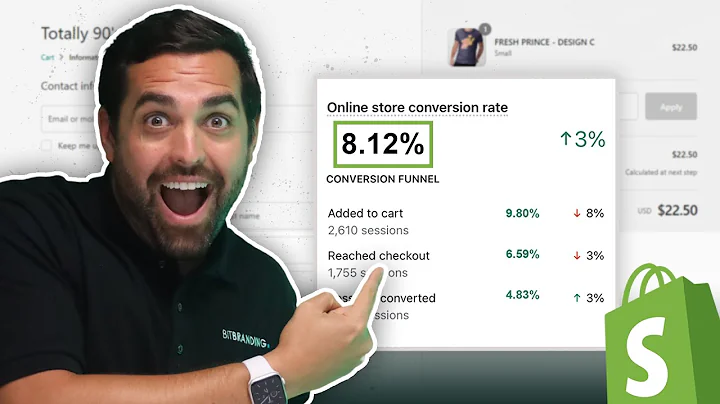Shopify's Dominant Rise: A Lesson for Entrepreneurs
Table of Contents
- Introduction
- The History of Shopify
- Venture Funding
- Seed Funding
- Series A Funding
- Series B Funding
- Series C Funding
- The IPO
- Turning Point: From E-commerce to Commerce
- Growth and Challenges
- Revenue and Loss Since the IPO
- The Impact of COVID-19
- Lessons from Shopify
- Platforms Rule
- Build vs Buy
- What Got You Here, Won't Get You There
Introduction
In this article, we will delve into the fascinating story of Shopify, one of the leading e-commerce platforms in the world. From its humble beginnings to its explosive growth, we will explore the history, venture funding, and IPO of Shopify. We will also examine the turning point that propelled Shopify from being an e-commerce platform to a commerce powerhouse. Additionally, we'll discuss the challenges faced by Shopify and the lessons we can learn from its success. Join us on this journey to discover how Shopify became a retail giant.
The History of Shopify
Shopify was founded in 2006 by Tobias Lutken, Scott Lake, and Daniel Weinand. The initial idea behind Shopify was to create an online platform called Snow Devils, where snowboards could be sold. However, the founders soon realized that their idea had the potential to revolutionize e-commerce. They rebranded the platform as Shopify and embarked on a journey to transform the way businesses sold their products online.
Venture Funding
To turn their vision into reality, Shopify needed capital. The company started with a seed funding of $250,000, a modest amount for a startup. Over the years, Shopify secured additional funding through various series of investments. These included a Series A funding of $7 million, a Series B funding of $15 million, and a Series C funding of $100 million. These investments helped fuel the growth of Shopify and position it as a major player in the e-commerce industry.
The IPO
In May 2015, Shopify went public with its IPO. This marked a significant milestone in the company's journey, providing additional resources to further expand its operations. The IPO allowed Shopify to raise funds and gain more visibility in the market, paving the way for its future success.
Turning Point: From E-commerce to Commerce
A defining moment for Shopify came in 2009, when the company realized it could be more than just an e-commerce platform, but a complete commerce solution. With the addition of payments and inventory systems, Shopify positioned itself as a comprehensive platform that enabled businesses of all sizes to manage their entire commerce operations. This shift from e-commerce to commerce allowed Shopify to attract a wider range of customers, including high volume retailers and small businesses.
Growth and Challenges
Since going public, Shopify has experienced both tremendous growth and challenges. Its revenue has steadily increased, but the company has also faced losses in certain years. It wasn't until 2020, amid the global pandemic, that Shopify saw a remarkable surge in revenue and turned a profit. The impact of COVID-19 and the shift towards digital commerce created the perfect storm for Shopify's success.
Lessons from Shopify
From Shopify's journey, there are valuable lessons that entrepreneurs and businesses can learn. Platforms rule in the digital age, with Shopify serving as a prime example of the power of platforms. The build vs. buy strategy employed by Shopify allowed them to enhance their platform by acquiring complementary technologies and companies. Lastly, the realization that what got you to one level of success may not be sufficient to reach the next level is an important lesson for any business seeking sustainable growth.
Highlights:
- Shopify, a leading e-commerce platform, has experienced significant growth and success in the retail industry.
- The company was founded in 2006 and initially focused on selling snowboards online under the name Snow Devils.
- Shopify raised venture funding, including a total of $122.3 million through various series of investments.
- A turning point for Shopify came when it expanded from being an e-commerce platform to a comprehensive commerce solution.
- Shopify's revenue has grown over the years, with a major boost in 2020 due to the impact of COVID-19.
FAQs
Q: How did Shopify go from selling snowboards to becoming a major e-commerce platform?
A: Shopify started as an idea to sell snowboards online, but its founders soon realized the potential for creating a broader e-commerce platform. They rebranded as Shopify and expanded their offerings to include a comprehensive solution for businesses to manage their online sales.
Q: How did venture funding contribute to Shopify's growth?
A: Venture funding played a crucial role in Shopify's growth, providing the company with the capital needed to develop its platform, expand its operations, and attract top talent. Through a series of funding rounds, Shopify raised a total of $122.3 million.
Q: What challenges has Shopify faced along the way?
A: Despite its success, Shopify has faced challenges, including periods of losses in revenue. However, the company managed to overcome these challenges and experienced a significant uptick in revenue and profitability, particularly during the COVID-19 pandemic.
Q: What lessons can businesses learn from Shopify's journey?
A: Some key lessons from Shopify's success include the power of platforms in the digital age, the strategic use of acquisitions to enhance a company's offerings, and the need to adapt and evolve as markets and customer needs change. Additionally, Shopify's growth during the pandemic highlights the importance of embracing digital commerce trends.






















